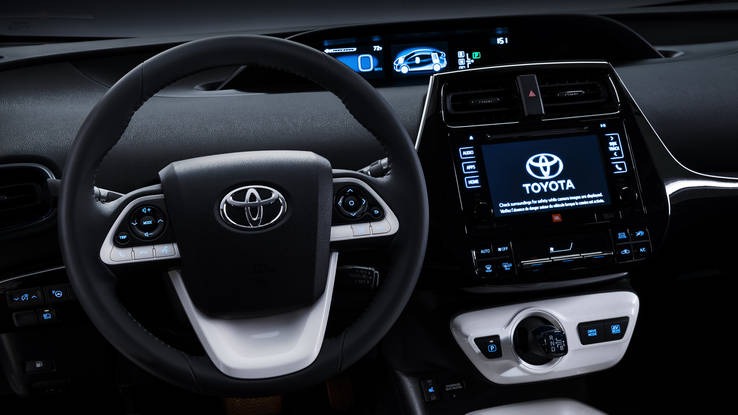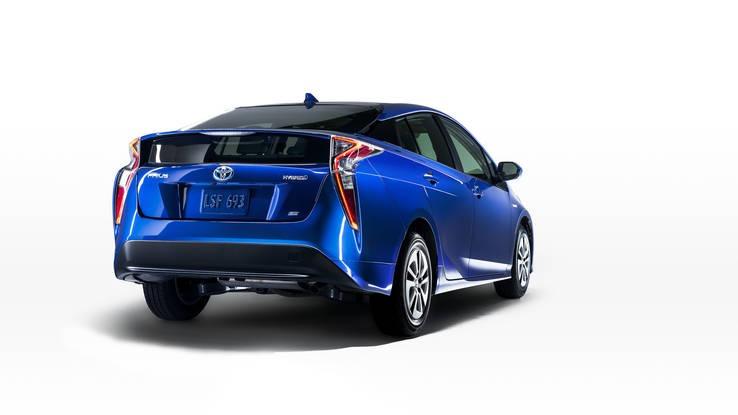Fourth-gen compact hybrid is a win for Toyota
The Prius has come a long way between the shoe-shaped first generation and the wildly-styled fourth generation. A lot has changed, but the spirit of the original Prius lives on.
The important change? Toyota has made the Prius fun to drive. I said it – fun. Unlike the previous generations that were capable as wheeled appliances, but lacked any of the interesting driving characteristics that actually make a car enjoyable behind the wheel, the new Prius handles well and delivered enough power to surprise me.
The gas engine is an I4 that churns out 95 hp; with help from the electric motor the net figure rises to 121 hp. The CVT compliments the hybrid technology, rendering smooth, steady acceleration. Compared to the previous generation, this Prius feels faster despite having less net horsepower. Of course, those interested in a Prius are often more concerned with MPGs, and the new car doesn’t disappoint: 54 mpg city, 50 mpg highway and 52 mpg combined.

Autoweek editors review the fourth-generation Toyota Prius.
The interior is similar to that of the previous generation, with some notable differences. The gear selector is now perpendicular to the dash, and there is a wireless charging mat in the center console. The mid-dash-mounted gauge cluster is still used, a feature that takes some getting used to, though a heads-up display makes life easier.
The newest Prius won’t convert the nay-sayers, but people on the fence about stepping into the most recognized hybrid on the planet might be swayed by how much better it is compared to previous generations.
— Wesley Wren, associate editor

Autoweek editors review the fourth-generation Toyota Prius.
OTHER VOICES:
On autoweek.com we said the new Prius is a “Prius that doesn’t drive like a Prius.” I don’t know if I’d go that far. I’d say it drives slightly better, but still like a Prius.
The new design is certainly edgy and angular, so like it or loathe it at least you can tell it’s the new one. Underneath is Toyota’s New Global Architecture (TNGA). We’ll see it next under the next Corolla and it uses more high-strength steel, enough for Toyota to claim a 60-percent improvement in rigidity.
Slide behind the wheel and it is indeed an improved experience. The seating position is lower and build quality looks quite a bit better. I don’t know that Toyota changed the center screen. If so I can’t tell the difference.
So far so good; on to the driving.
The 95 hp figure is actually 3 less than the outgoing model; the 121 hp combined is 13 less. Even with less power the car somehow feels about the same accelerating away from lights and such. Not noticeably faster or slower. The new car is quite a bit quieter on the road – less tinny. It also handles better, but again, I wouldn’t call it a dramatic change from what I recall. I’d say the steering is quicker, body roll slightly improved and this car feels more stable. More nimble too. But “sportier to drive” as Toyota promised last fall? Hmmm. Maybe if you squint. Or maybe driving the old and new back to back would help. I still dislike strongly the re gen brakes. They’re like an on/off switch.
Efficiency is the name of the game though, and while I didn’t have to fill it, the in-dash mpg meter said I averaged 50 mpg. Impressive.
— Wes Raynal, editor

Autoweek editors review the fourth-generation Toyota Prius.
Well, I don’t hate it. Toyota’s reputation for conservative styling is so strong that it has persisted in the face of a number of recent, genuinely zany looking cars and trucks. Maybe this wacky Prius will be the impetus for a reappraisal of the Toyota line’s styling; it has been for me. The interior could do without the white, Volt-inspired center console, though it’s generally more attractive than the one it replaces.
Toyota also made a point of telling us that this Prius is more fun to drive, and also admitting that “fun” isn’t something that Prius customers have asked for. (You probably know a Prius driver, try for a second to imagine what fun means to them.) It isn’t a Miata, but it’s now a car that encourages you to see how much speed you can carry through an on-ramp. Sure, going from punitive to smirk-inducing isn’t exactly climate-science, but I’m not going to fault Toyota for the effort.
— Rory Carrol, content director
Options: None




























